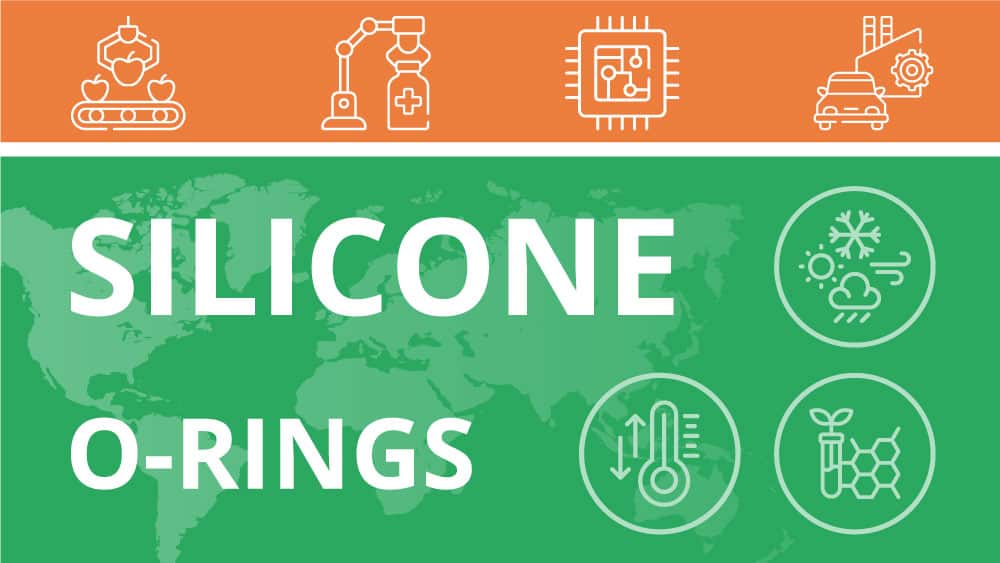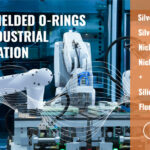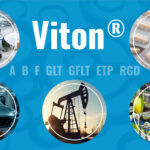
Summary
- Silicone o-rings are distinguished by their temperature resilience, resistance to weather conditions, and bio-inert characteristics, which make them ideal for various applications.
- Despite the existence of other materials like Nitrile, Viton, and EPDM, silicone o-rings excel in numerous sectors, including food and beverage, medical, electronics, and automotive due to their unique properties.
- The field continues to evolve with the development of liquid silicone rubber (LSR) and the use of material fillers, which has led to market growth and increased demand in various industries.
Introduction
In industrial equipment, the o-ring is a silent, steadfast workhorse. Its simplicity equates to its genius; a loop of elastomer with a round cross-section, designed to be seated in a groove and compressed during assembly to form a seal. The simple o-ring is an integral part of the industrial machinery, facilitating the smooth running of everyday life as we know it. Among the vast array of o-ring materials available, silicone o-rings hold a special place due to their unique properties.
Silicone o-rings are known for their impressive range of temperature compatibility, excellent resistance to various external factors, and flexibility. But just like any material, they come with their own set of limitations. In this comprehensive guide, we delve into the nuances of silicone o-rings—their advantages, disadvantages, and applications. Additionally, we’ll explore how silicone stands against other popular o-ring materials and share some invaluable tips for selection and maintenance.
History of Silicone O-Rings
Like many other industrial products, silicone o-rings have a rich history rooted in the rapid growth of technology and innovation during the 20th century.

- Discovery of Silicone: In 1901, Frederick Kipping developed the first silicone polymers, laying the groundwork for silicone o-rings.
- Mass Production: Silicone was refined and mass-produced during World War II to meet the aircraft industry’s needs for a material resistant to extreme temperatures.
- Commercial Expansion: Post-war, commercial applications of silicone grew rapidly, especially in the sealing industry.
- Silicone Rubber Development: The 1960s saw the creation of silicone rubber, opening new avenues for o-ring usage thanks to its unique properties, such as temperature stability, flexibility, and biocompatibility.
- Rise of Silicone O-Rings: Due to increasing industrialization post-war, the demand for reliable sealing solutions surged, leading to the widespread adoption of silicone o-rings in various industries.
- Modern Improvements: Today, with advancements in technology and manufacturing, silicone o-rings are produced in various sizes and hardness values, tailored for specific applications.
The story of silicone o-rings is a testament to the power of innovation and adaptation. They have become an essential component in industries worldwide since their modest beginnings. As technology continues to evolve, so will the role of silicone o-rings, securing their place in the annals of industrial history.
The Pros of Silicone O-Rings
- Wide Temperature Range: Silicone o-rings can operate in temperatures as low as -60 degrees Celsius and as high as 225 degrees Celsius or -76 degrees Fahrenheit to 437 degrees Fahrenheit, making them a versatile choice for industries with machinery operating in extreme temperature conditions.
- Exceptional Resistance: These o-rings boast excellent resistance to weathering, ozone, and UV rays. They maintain their flexibility and sealing abilities in various environmental conditions, making them ideal for outdoor applications.
- Bio-inert Nature: Silicone o-rings are non-reactive with biological materials, making them suitable for the food and beverage industries, where they often come into contact with edible items and ensure no harmful chemicals leach into the food.
- Medical Applications: The bio-inert property of silicone o-rings also extends to medical applications, where they are used in various types of equipment. Their non-reactivity ensures safety and reliability in sealing medical devices and facilitating fluid transfer.
- Electrical Insulation: Known for their electrical insulating properties, silicone o-rings can effectively resist electricity, making them ideal for electrical and electronic equipment use. This property, along with silicone’s thermal stability, makes these o-rings perfect for electrical insulation applications.
Silicone vs. Other Materials

When choosing an o-ring, it’s essential to consider the operating environment and the specific demands of your application. Comparing silicone to other materials such as Nitrile, Viton (FKM), and EPDM can help you make a more informed decision.
Nitrile o-rings, for example, are known for their excellent resistance to petroleum-based oils and fuels, a property that silicone lacks. They also possess superior abrasion resistance compared to silicone. However, Nitrile doesn’t match silicone regarding temperature extremes and weather resistance.
Viton (FKM) o-rings are another popular choice. They are noted for their resistance to chemicals and high temperatures, surpassing silicone in certain aspects. However, FKM o-rings can’t match silicone’s flexibility at low temperatures or its electrically insulating properties.
EPDM o-rings provide excellent resistance to weather, ozone, UV rays, and certain chemicals. In these aspects, they are comparable to silicone. However, EPDM doesn’t perform as well with petroleum-based oils and is generally less suitable for food or medical applications than silicone.
In essence, each o-ring material has its strengths and weaknesses, and there are scenarios where silicone outperforms others and vice versa. Thus, it’s crucial to consider the specific needs of your application when selecting the o-ring material.
Applications of Silicone O-Rings
Silicone o-rings find wide-ranging applications in diverse industries, notably the food and beverage and medical and pharmaceutical sectors. They also find use in the electronics and automotive industries. Their unique properties, such as temperature stability, flexibility, and biocompatibility, make them indispensable in numerous scenarios.
Food and Beverage
Silicone o-rings are often the go-to choice in the food and beverage industry. One primary reason for this preference is their bio-inert nature. When we think about the critical functions that seals perform in this industry, it becomes clear why this attribute is crucial. They often come into contact with foodstuffs or liquids meant for consumption. Consequently, it’s vital for these seals not to leach potentially harmful substances or alter the taste. silicone o-rings excel in this regard as they’re not reactive and don’t influence the properties of the products they come in contact with.
These industries also favor silicone o-rings for their resistance to extreme temperatures. Food and beverage industry processes often involve heating or cooling at various stages, from cooking and pasteurization to refrigeration. Silicone’s ability to withstand a wide temperature range ensures it can operate effectively in these varied environments. Consider beverage dispensers, for example, which often deal with hot and cold drinks. Silicone o-rings within these machines maintain an effective seal, regardless of the beverage temperature, contributing to consistent performance and long equipment life. Another example is the common heat sealing method used to preserve the freshness of packaged food. Here, silicone o-rings can withstand the high temperatures involved in sealing while ensuring an airtight seal to keep the food fresh.
Medical and Pharmaceutical
The medical and pharmaceutical sector presents unique challenges for sealing solutions. Safety and reliability are paramount in this industry, and silicone o-rings rise to the occasion. Their excellent biocompatibility makes them suitable for a wide range of medical applications. They’re non-toxic, hypoallergenic, and don’t react with bodily fluids or tissues, making them ideal for external and internal applications.
One specific example is their use in drug-delivery devices like insulin pumps. These pumps need to maintain a precise and reliable delivery of medication. Silicone o-rings provide an effective seal that can endure the constant mechanical stress of dispensing the medication while ensuring it remains uncontaminated.
Silicone o-rings also find use in critical care equipment such as medical ventilators. These life-support machines need to maintain an airtight connection to function effectively. Given their extreme temperature resistance, silicone o-rings can withstand these devices’ sterilization processes without compromising their sealing efficiency. Another example of using silicone’s heat resistance is within laboratory equipment. Whether it’s autoclaves used for sterilization or heated mixers used in chemical analysis, the ability of silicone o-rings to withstand high temperatures while maintaining a reliable seal is precious.
Other industries
The electronics industry uses silicone o-rings in a variety of applications. From providing thermal stability in high-temperature electronic devices to ensuring efficient insulation in electrical circuits, silicone o-rings are highly beneficial for this sector.
The automotive industry also benefits from the use of silicone o-rings. While they aren’t suitable for fuel-related applications due to their incompatibility with petroleum-based substances, they find extensive use in other areas like HVAC systems and electrical applications within automobiles.
Selection and Maintenance Tips
To ensure optimal performance and longevity of an o-ring, it is important to evaluate both its operating conditions and subsequent maintenance routine.
Considerations for Selection:
- Type of fluid exposure
- Range of operating temperatures
- Potential exposure to harsh environmental conditions
- Mechanical stresses the o-ring will need to withstand
Maintenance:
- Lubricate with silicone-based lubricants to maintain elasticity and extend lifespan.
- Regular inspection for signs of aging (cracking or deformation) is crucial.
- Prompt replacement of worn-out o-rings to prevent equipment failure.
For more information on the shelf life and maintenance of o-rings, click here.
Noteworthy Innovations in Silicone O-Ring Technology
Silicone o-ring technology, while already remarkable in its wide range of applications and durability, continues to advance. These improvements expand silicone o-rings’ reach further, enhancing their resilience, versatility, and cost-effectiveness.
One significant innovation is the development of liquid silicone rubber (LSR). LSR has similar properties to solid silicone but is easier to mold into intricate designs. This property allows for more sophisticated applications requiring precise sealing solutions. Check out our blog post on liquid silicone rubber applications to learn more.
Another advancement is in the realm of material additives. Including fillers in the silicone compound can improve properties such as tensile strength, flame resistance, or thermal conductivity. Depending on the application’s requirements, these additives can make silicone o-rings more resilient and capable.
Innovations are also being seen in the manufacturing processes to improve production efficiency and the quality of the final product. For example, flashless molding, an advanced manufacturing technique, can produce o-rings with superior dimensional accuracy and reduced waste.
Future Trends in the Silicone O-Ring Market
The silicone o-ring market continues to grow, driven by increasing demand from diverse industries. From electronics and automotive to food & beverages and medical applications, the versatile benefits of silicone o-rings fuel their expanding use.
- Market Growth: Industry reports predict steady growth for the silicone o-ring market due to rising global industrial output and the increasing need for reliable sealing solutions.
- Medical Applications: The biocompatible nature of silicone o-rings is driving their growing use in advanced and miniaturized medical devices.
- Challenges: Fluctuations in raw material prices and the impacts of global events on supply chains pose potential challenges.
- Positive Outlook: Despite possible challenges, the silicone o-ring industry maintains a positive outlook due to technological advancements and the adaptability of silicone o-rings.
Conclusion
In conclusion, silicone o-rings serve as indispensable components across numerous industries. They offer unique advantages, and while they have their limitations, their versatility makes them a valuable asset. Choosing the right o-ring material for your application is crucial, and we at Global O-Ring and Seal are here to help. Together, we can ensure your operations’ efficiency, longevity, and success. From initial selection to maintenance tips, our expert team will guide you through every step. Our commitment to quality assurance and exceptional customer service sets us apart. At Global O-Ring and Seal, we’re here to provide solutions that work for you. To shop for silicone o-rings, visit our online store or click here.

 English
English  Español
Español  Français
Français  Português
Português  Deutsch
Deutsch  Italiano
Italiano  Русский
Русский  中文
中文  日本語
日本語  العربية
العربية  हिन्दी
हिन्दी 



